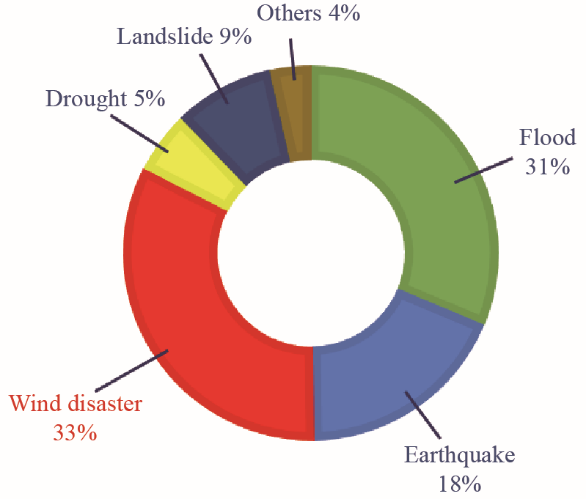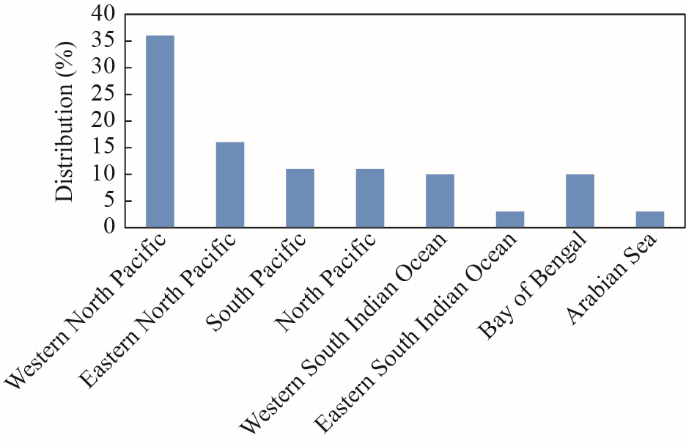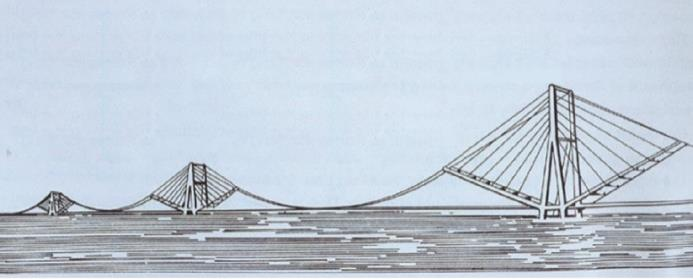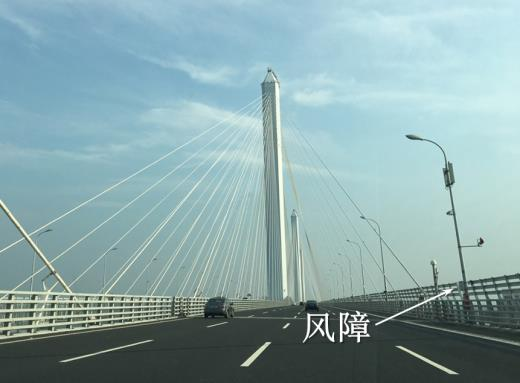《1 Introduction》
1 Introduction
With the rapid development of the economy and society as well as the demand for interoperability requirements, the requirements of humans to cross the straits or seas have gradually increased, which necessitates the extension of bridge projects from inland to offshore and even deep sea [1–3]. In the past few years, China has demonstrated remarkable achievements with respect to the construction technologies of offshore bridges with the successive construction of Donghai Bridge, Hangzhou Bay Bridge, and Hong Kong–Zhuhai–Macao Bridge, as well as the ongoing construction of Pingtan Strait Bridge.
In the future, with the continuous development of national highways and railway networks as well as the continuous advancement of a series of major strategic decisions, such as the national “Ocean Power” strategy, “Traffic Power” strategy, and the “Belt and Road Initiative”, China is planning to construct marine bridges that cross over Qiongzhou Strait, Bohai Bay, and Taiwan Strait. Moreover, some other countries along the “Belt and Road” are also planning to construct marine bridges over deep seas, such as Tiida Strait (Indonesia) and Caspian Strait (from Russia to Iran). However, compared to the constructions of offshore and inland long-span bridges, future marine bridge constructions will encounter harsher environmental effects due to complex wind fields [4,5]. China is one of the few countries all over the world that has been seriously affected by the typhoon or strong wind, as shown in Fig. 1. It is evident from the existing research and engineering practical point of view that the wind and its effects play a very important role during the design, construction, and operation of future marine bridges [6–8]. Therefore, devising appropriate approaches to ensure the safety of marine bridges during the construction and operation stages against strong winds has become one of most serious challenges for wind engineers.
《Fig. 1》

Fig. 1. Proportion of natural disasters in China.
《2 A state-of-the-art review》
2 A state-of-the-art review
《2.1 Wind characteristics of marine bridge sites》
2.1 Wind characteristics of marine bridge sites
China’s current design methods and standards corresponding to the wind resistance for bridges are based on synoptic climate, and therefore, wind parameters, such as the gust factor, mean wind speed profiles, integral length scale, and turbulence spectra, are determined especially for the monsoon climate characteristics in inland area [9]. However, the northwestern Pacific in the east of China is the region with the most typhoon occurrences all over the world. This region has encountered approximately 35 typhoon occurrences per year, which constitute 36% of those all over the world, as shown in Fig. 2. Typhoon in this region, which include larger power index of mean wind speed profile, higher gust factor, significant increase in surface roughness, and obvious non-stationarity than those in the current standards, are very different from those of the synoptic wind. In contrast, due to the strong randomness of the typhoon trace and non-uniformity of the typhoon wind field, it is very difficult to measure the wind characteristics of typhoon on sites with accuracy. The insights relating to the wind characteristics of typhoons over various terrains, especially their turbulence properties, are very preliminary. Moreover, the existing offshore and marine meteorological observation platforms are inadequate, and the sampling data is limited and relatively inaccurate. A local comprehensive meteorological observation and forecast platform is not available within the scope of the bridge site to provide a strong support for the construction and operation of future marine bridges over deep-sea.
《Fig. 2》

Fig. 2. Distribution of typhoons in various regions of the world.
Several studies have been conducted to investigate or simulate the typhoon wind fields, and therefore, many numerical typhoon models, such as the Batts model [10], Vickery model [11], Yan Meng model [12], and the US Army Corps of Engineers model [13], have been established to obtain accurate extreme wind speed values. Although the aforementioned typhoon random numerical simulation models are relatively mature and can effectively evaluate the extreme wind speed of typhoon wind fields, its applicability to the typhoon wind fields in China’s coastal areas remains uncertain. These typhoon models, which employ simplified dynamic equationsto evaluate the typhoon wind fields, cannot consider the complex atmospheric physical process and the influence of the underlying surface. Thus, the structure and distribution of the simulated near-surface typhoon wind fields based on these models differ significantly from the actual situation. To obtain more accurate information on the near-ground wind field, some researchers identified a more accurate average wind field structure of typhoon [14] based on the Weather Research and Forecasting (WRF)-Advanced Research WRF model, which is used along with the three-dimensional numerical simulation method. However, the results of this structure demonstrate limited data resolution. Therefore, they are not capable of effectively simulating the characteristics of fluctuating wind fields and completely satisfying the design and construction requirements of long-span marine bridges.
《2.2 Wind effects on long-span bridges》
2.2 Wind effects on long-span bridges
The existing wind-resistance theory and method for long-span bridges primarily categorizes the wind effects exerted on bridge structures into the aerostatic effect caused by mean wind flow, buffeting force caused by turbulent flow, vortex-induced force caused by periodic vortex shedding, and self-excited force caused by structural motion. Corresponding theoretical calculation models have also been established to determine the identification parameters experimentally and analyze the structural catastrophic behavior.
The static effect of wind on the bridges is one of the earliest problems experienced by humans. The problem relating to structural safety is mainly caused due to aerostatic instability. The existing iterative analysis method can obtain the critical wind speed of aerostatic instability under uniform flow accurately. However, the aerostatic stability of marine bridges under strong turbulences, such as the ones that result in case of a typhoon, has still not been studied in depth.
The vibration of bridge structure induced by natural wind, in turn, changes the flow structures around it, and thus affects the flow field and aerodynamic forces. This is the interaction mechanism between the wind and the structure. As the influence of structural vibration on the aerodynamic force is minimal, the dynamic effects of wind can be regarded as a forced vibration load, which mainly leads to the forced vibration of the bridge structure, called the random vibration. As the structural vibration exhibits a greater influence on the flow structures, the aeroelastic induced by interaction between the wind and the structure can be dominant, which leads the self-excited vibration of the bridge structure, including flutter or galloping. In recent years, a variety of aerodynamic models as for aforementioned effects has been established with the development of the identification theory and techniques of aerodynamic parameters for the bluff bridge section (i.e., the aerodynamic coefficient, flutter derivative, and aerodynamic admittance function), which effectively ensures the stability, safety, and comfort of long-span bridge under synoptic winds. However, typhoon is very different from the synoptic wind, and the mechanism of its effects on the bridges is still unclear. What’s more, the marine bridges demonstrate a larger span, more complex structural system, and lower stiffness and damping, which can render the three-dimensional and nonlinear effects to be more significant. Obviously, the current wind-resistance theory is not so accurate and cannot satisfy the requirements of marine bridge construction.
In addition, the current design codes corresponding to the wind resistance for bridges provides only a single evaluation standard for the wind-induced vibrations of bridges, including vortex-induced vibration (VIV) and flutter. These codes are not suitable for evaluating the wind-resistant performance of super-long-span marine bridges. Significant amount of basic research work is critically required in this direction.
《2.3 Control techniques for wind-induced vibrations》
2.3 Control techniques for wind-induced vibrations
Wind-induced vibrations need to be controlled to ensure the safety and driving comfort of long-span bridges. The primary countermeasures that can be employed are structural, aerodynamic, or mechanical.
In terms of structural measures, the application of spatial cable systems and cross ties can improve the windresistant ability the bridges. However, the use of spatial cable systems can suffer drawbacks, such as construction difficulties and complex forces under construction, as well as the complicated design and installation processes of cross-ties. Although the combined structure (Fig. 3) [15] can theoretically satisfy the construction requirements of the future super-long-span marine bridges, it can encounter problems, such as complex structural forces, high construction costs, complicated construction techniques, and lack of construction experience in such projects. Moreover, there is no clarity on the criticality of problems that can be caused by wind during the construction process.
《Fig. 3》

Fig. 3. Design of the Gibraltar Straits Bridge [15].
Aerodynamic measures are used most commonly to suppress or mitigate wind-induced vibrations. As the aerodynamic performance of the structure can be improved by changing the aerodynamic configuration of members, such as the main girder, tower, cable and so on, as well as by installing stabilizers or guide vanes, these aerodynamic measures are extensively applied to improve the wind-resistant ability. In the future, long-span marine bridges encounter certainly a wider range of wind speeds, and therefore a variety of wind-induced vibrations may occur, which asks for a countermeasure to control multi wind-induced vibrations. However, only few studies were paid attention to this aspect.
The current mechanical measures mainly adopt passive, semi-active, and active methods to control wind-induced vibrations. For example, the tuned mass damper technology has been widely used for wind-induced vibration control of bridge towers and main girders. The viscous shear damper and magneto rheological damper technologies have been used to control cable vibrations. Related studies have shown that the active aerodynamic control technology (Fig. 4) is more reasonable and efficient in wind-induced vibration control of the main girder [16,17]. However, this technology is still being researched in laboratory, and few application cases have been reported.
《Fig. 4》

Fig. 4. Huynh active control surface additional aerodynamic action model [16].
The marine bridge construction has entered a new era to cross deep seas. Both possibility and necessity of applying countermeasures for wind-induced vibrations has grown rapidly. It is of critical importance to develop novel and more efficient structural systems, as well as control techniques for wind-induced vibrations.
《2.4 Driving safety on bridges》
2.4 Driving safety on bridges
The issue of safe driving on marine bridges is more prominent compared to that on the inland bridges. Currently, the main countermeasures against cross wind include setting windbreaks (Fig. 5) [18] and setting lanes inside the box girder. The primary operation control method against strong wind includes implementing the required speed limit and other traffic restrictions during severe weather conditions based on the meteorological observations near the bridge site [19]. A related research based on a specific bridge preliminarily revealed the effect of wind on the safety and comfort of vehicle drivers on the bridge deck. A fundamental method for evaluating the driving safety and comfort has been established. The application of wind barrier and traffic control measures has improved the service of large-pan bridges during windy days to a certain extent. However, the aforementioned wind-proof technologies and management methods are aimed at resolving problems related to driving safety on inland or offshore bridges. Only few studies have been conducted so far on wind-resisting measures for driving safety on deep-sea bridge projects.
《Fig. 5》

Fig. 5. The windbreak at Jiashao Bridge.
《3 Challenges in devising a wind-resistant design for marine bridges》
3 Challenges in devising a wind-resistant design for marine bridges
The research on wind resistance of long-span bridges has achieved significant improvement, which ensures that the wind-resistant ability of inland and offshore bridges can satisfy the requirements corresponding to synoptic winds by application of aforementioned theories and countermeasures. However, several challenges which may be encountered during the design, construction, and operation of long-span marine bridges in the future, are mainly sorted out from four aspects as in the following sections.
《3.1 Wind characteristics at marine bridge sites》
3.1 Wind characteristics at marine bridge sites
The wind environment faced by marine bridges is more complicated in two aspects. On the one hand, marine bridges encounter typhoons more frequently than offshore and inland bridges; however, the key wind parameters of typhoon, such as extreme wind speed, mean wind speed profile, and turbulent characteristics, obviously differ from the strong synoptic winds. Moreover, an appropriate and accurate mathematical model to describe the wind field of typhoon is currently not available. On the other hand, the wind field over sea generally has high velocity, variable direction, significant non-stationary and obviously local climatic characteristics. The resolution of existing measured data is relatively low due to that the current meteorological observing stations are limited, and relevant researches such as experimental and numerical studies, are also minimal. Therefore, it is clear that there are numerous challenges in developing actual engineering applications.
The study of wind field at marine bridge sites is a subsets of fluid mechanics, meteorology, and applied physics. The challenges are still complex, and significant information, such as the flow structure of typhoon field and local climate characteristics of the bridge site, lacks clarity. Comprehensive meteorological observation and forecasting platforms for engineering construction and operation are still not sufficient. Therefore, considerable amount of research work is required to examine the wind characteristics at marine bridge sites.
《3.2 Wind-resistant design theory and applicable specifications for super-long-span marine bridges》
3.2 Wind-resistant design theory and applicable specifications for super-long-span marine bridges
As the generation mechanism and spatial-temporal characteristics of wind fields at marine bridge sites are very different from those of synoptic wind fields, the mechanism of this kind of wind effects on marine bridges is not clear. Therefore, the aerodynamic model and wind-resistant design method that have been established based on the test conducted in the uniform flow and the conventional turbulent flow cannot explain the aerodynamic behavior of a super-long-span marine bridge under typhoon conditions. It is critically important to study the factorsthat influence the aerodynamic parameters of the main girder in the typhoon environment. This can aid in devising a reasonable aerodynamic parameter model with improved accuracy and a higher scope of application.
Establishing a scientific evaluation standard for the wind resistance performance of a large-span marine bridge is highly complicated. Moreover, a substantial amount of research work is still required in this direction. The windresistant safety assessment in the current code is mainly applicable for the wind fields at long-span bridges under normal climatic conditions. The current standard is not comprehensive and cannot be directly used to evaluate the wind-resistant performance of large-span bridges. The long-span marine bridges are important in the transportation network, though their wind environment is complex. Therefore, it is important to comprehensively consider various factors and determine reasonable and scientific evaluation criteria to ensure the safety and comfort of transport over large-span marine bridges.
《3.3 Wind-induced vibration control for structural safety and driving comfort》
3.3 Wind-induced vibration control for structural safety and driving comfort
With the advancement of bridge constructions across seas, bridges of larger span are highly in demand. From the perspective of structural wind resistance, the existing bridge structure and construction methods may encounter new challenges, as the traditional wind control methods demonstrate many limitations. Although structural measures, such as the spatial cable system and the new composite structure, can improve the structural rigidity and improve the wind resistance of the bridge to a certain extent, the structural stress is complicated, and the force transmission transfer mechanism is unknown. There are many structure system conversions during the construction process, which makes the process complicated. The key wind resistance problems in the construction process need to be resolved, and therefore, it is critical to develop novel and more efficient wind-induced vibration control measures.
In the future, marine bridges may experience high wind speeds with a wide range. The probability of multiple wind-induced vibrations on large-span bridges is higher. The compatibility of traditional passive aerodynamic measures is poor. Therefore, it is necessary to propose optimized aerodynamic measures that can simultaneously control various wind-induced vibrations.
Active aerodynamic vibration control is more reasonable and efficient in providing wind-induced vibration control of the main girder. It is the future trend with respect to the wind-induced vibration control of super-longspan bridges. However, this technology suffers some drawbacks, such as incomplete action mechanism, poor reliability, and high energy supply dependence.
《3.4 Driving safety and traffic operation》
3.4 Driving safety and traffic operation
In the future, the service environment of marine bridge projects is expected to be worse due to the global climate change. The sea surface winds are strong, and windy weather is frequent. As a result, several traffic accidents have occurred frequently, causing serious economic losses and social impacts. It is difficult to propose a countermeasure for driving safety under severe climatic conditions, such as strong winds, that doesn’t significantly affect the wind resistance of bridge structures.
Establishing a perfect wind weather warning system, devising a complete and effective intelligent traffic operation management system after considering the structural form, vehicle type, and road surface conditions, and enhancing the capacity of marine bridges are important aspects that need to be addressed during the construction of marine bridges in the future.
《4 Strategies of wind-resistant design for future marine bridges》
4 Strategies of wind-resistant design for future marine bridges
To address the requirements of future marine bridge constructions, it is necessary to handle the following four aspects as a part of wind resistance research.
《4.1 Studying the characteristics of wind farms at marine bridge sites》
4.1 Studying the characteristics of wind farms at marine bridge sites
4.1.1 Conducting research work on the small-scale characteristics measurement of typhoon
In recent years, the research of typhoon field measurement in China has developed rapidly, and numerous largescale and mesoscale meteorological data have been obtained. However, the small-scale data required for the construction of marine bridge is still scarce. Therefore, the small-scale characteristics measurement research of typhoons from the engineering point view must be conducted to obtain the spatiotemporal characteristics of typhoon average and turbulent wind fields.
4.1.2 Developing numerical simulations for small-scale typhoons
Currently, the common technology is used to obtain more accurate average wind field data based on the WRF mesoscale numerical model. However, the resolution of this data is poor and far from the actual engineering requirements. Based on the existing research, the numerical simulation based on computational fluid dynamics should be used to establish a small-scale numerical model of typhoons to obtain key information, such as wind speed time history, turbulence characteristics, and wind profile characteristics at different scales.
《4.2 Development of wind-resistant design theories and specifications applicable for super-long-span marine bridges》
4.2 Development of wind-resistant design theories and specifications applicable for super-long-span marine bridges
4.2.1 Establishing wind-resistant design theories for super-long-span marine bridges
According to the over-sea wind field and structural characteristics of large-span marine bridges, it is important to devise the mechanism of typhoons on extra-large span bridges and develop a more realistic 3D typhoon wind field model to analyze their aerostatic stability, vortex-induced vibration, flutter, and buffeting.
4.2.2 Proposing wind resistance performance evaluation standard for super-long-span marine bridges
The evaluation standard of wind resistance performance of super-long-span marine bridges is the key to estimate the wind-resistant performance of marine bridges. Scientific decision-making involves a wide range of complicated processes, where considerable amount of fundamental research work is critically required.
《4.3 Developing wind-induced vibration control technologies for structural safety and driving comfort》
4.3 Developing wind-induced vibration control technologies for structural safety and driving comfort
4.3.1 Developing novel structural systems to satisfy the wind-resistant safety and driving comfort
With the advancement of bridge construction projects across seas, the traditional bridge structure system may not satisfy the wind resistance requirements. Therefore, it is necessary to conduct some research on the structure type, main girder form, and cable system of the bridge and propose a novel structural system that can satisfy the windresistant safety and driving comfort of marine bridges.
4.3.2 Developing new construction techniques for marine bridge constructions
Windy weather is common at seas, and the wind speed is high as well. It means the wind environment during the construction stage of marine bridges is even more severe, and thus the traditional long-span bridge construction methods may encounter new challenges. It is important to resolve the key issues related to wind resistance in the construction process and propose the construction technology and organization management applicable to marine bridges.
4.3.3 Developing active aerodynamic control technology
Active control technology is the trend of wind-induced vibration control measures for super-long-span bridges, which has demonstrated some progress in theoretical research. From the perspective of future engineering applications, it is critical to conduct substantial research work, such as investigating the mechanism of action, improving the reliability of practical applications, and resolving the energy supply problem encountered during the process of vibration suppression.
《4.4 Conducting research on technical measures to resist typhoons for driving safety and traffic capacity》
4.4 Conducting research on technical measures to resist typhoons for driving safety and traffic capacity
4.4.1 Research and development of new windproof measures for structural wind vibration control and driving safety
The windproof safety measures of existing bridges are not effective in improving the wind resistance of the structure. These measures deteriorate the wind resistance of the structure occasionally. It is critical to propose new windproof measures that do not significantly affect the wind resistance of the bridge structure and ensure driving safety under severe climatic conditions, such as strong winds at seas.
4.4.2 Establish an intelligent traffic operation management system for windy days
Aiming at the characteristics of climatic environments encountered by the marine bridges, a perfect climate early warning system must be established. Moreover, a complete and effective intelligent traffic operation management system should be formed considering the structural form, vehicle type, and road surface conditions to improve the capacity of sea bridges.
《5 Concluding remarks》
5 Concluding remarks
As China’s bridge construction projects progress from inland to ocean, several offshore bridges have been successively built along Chinese coasts, and an outstanding chapter in the history of China’s bridge construction has been created due to the innovation, practice, and careful construction.
In future, the marine bridge extends necessarily to the deep sea, which means the deterioration of marine climatic conditions and frequent extreme weather. However, the existing bridge wind resistance design theories and methods are not able to completely satisfy the requirements of future marine bridge construction. Ensuring the wind safety and driving comfort in marine bridges during construction and operation is a serious challenge.
The wind field characteristics of the marine bridge site and disaster mechanism of these projects under the extreme action of strong winds or typhoon must be studied in accordance with the complex environment conditions of the ocean, and wind-resistant safety design methods for marine bridge projects must be established. Moreover, the bridge wind-induced vibration control technologies must be investigated in terms of structural safety and driving comfort, and the wind-resistant measures must be examined in terms of driving safety and traffic capacity. It is of key importance to propose the wind-resistant design specifications of marine bridge engineering, and develop their safety warning system and intelligent operation management strategy against strong wind.
《Acknowledgements》
Acknowledgements
This research was funded in part by Key Consulting Research Project of China Academy of Engineering NO. 2016-XZ-13.













 京公网安备 11010502051620号
京公网安备 11010502051620号




